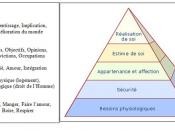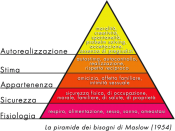Laura S Sides Black MGT 300 11-22-00
The success of any organization depends on the ability of managers to provide a motivating environment for its employees. Motivated employees are more productive, happier, and stay with the organization longer. One of the primary tasks a manager faces is to find out what motivates their staff. By understanding employee needs, managers can understand what rewards to use to motivate them. Abraham Maslow proposed the theory called hierarchy of needs theory (370-396). Maslow believed that within every individual, there exists a hierarchy of five needs and that each level of need must be satisfied before an individual pursues the next higher level of need. As the individual progresses through the levels of needs, the preceding needs lose their motivational value.
The five levels of needs, according to Maslow are: 1. Physiological Needs. These needs include food, water, and sex, which are essential for us to survive.
If these needs are not met, then all other needs will not be a source of motivation. 2. Safety Needs. This refers to the need to feel safe from physical and emotional harm. 3. Social Needs. These needs are concerned with social interactions with others. The individual needs to feel a sense of belonging, affection, acceptance, and friendship. 4. Esteem Needs. Esteem is concerned with the feelings of self-confidence derived from achieving something, and the recognition and prestige that comes with that achievement. 5. Self-Actualization Needs. This level of needs is concerned with achieving one full potential and dreams. Maslow hierarchy of needs theory is too simple and rigid. Humans are very complex with needs that overlap each other at different times. In other words, even if a level of need has been met in the past, this does not mean that this same level of...


